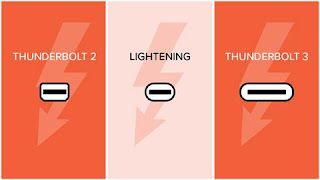There is one topic in the tech world that consumers continue to scratch their heads over and that is the difference between USB-C and Thunderbolt 3. The confusion often stems from the assumption that both cables use the same connector, however, this isn’t completely accurate as one of them isn’t really a cable at all.
Unlike USB-C, Thunderbolt 3 isn’t a type of cable. Instead, it is a superset of capabilities that runs on USB-C connectors and cables. Thunderbolt 3, therefore, is essentially the technology that brings Thunderbolt to USB-C.
No matter how tech savvy you are, there is one thing that makes everyone scratch their head...the difference between Thunderbolt 3 and USB-C. Thunderbolt has evolved over the years (Thunderbolt, Thunderbolt 2, and Thunderbolt 3). The newest version- Thunderbolt 3- has now integrated USB-C in order to provide consumers with a universal port, making Thunderbolt 3 the internal capability and USB-C the shape of the port . Because of this upgrade, many are confused about the difference between the two. Let's take a look at the capabilities each in order to grasp a clear understanding of the differences between the two.
Unlike USB-C, Thunderbolt 3 isn’t a type of cable. Instead, it is a superset of capabilities that runs on USB-C connectors and cables. Thunderbolt 3, therefore, is essentially the technology that brings Thunderbolt to USB-C.
No matter how tech savvy you are, there is one thing that makes everyone scratch their head...the difference between Thunderbolt 3 and USB-C. Thunderbolt has evolved over the years (Thunderbolt, Thunderbolt 2, and Thunderbolt 3). The newest version- Thunderbolt 3- has now integrated USB-C in order to provide consumers with a universal port, making Thunderbolt 3 the internal capability and USB-C the shape of the port . Because of this upgrade, many are confused about the difference between the two. Let's take a look at the capabilities each in order to grasp a clear understanding of the differences between the two.
Thunderbolt
3
Thunderbolt 3
travels at 40Gbps, making it twice as fast as Thunderbolt 2 for data
connection. Thunderbolt 3's swift connection between a laptop or desktop
monitor and an external graphics card allows for enhanced performance in
activities such as gaming, with little to no delay. It also provides a
boost in signal reception and high definition quality when interacting with
Virtual Reality headsets for optimal performance.
Thunderbolt 3 can
present video content on two 4K displays or one 5K display at 60Hz for a
heightened visual experience. Not only does it allow data transfer, video and
audio output- it can charge devices and give power from any port!
USB-C
There are many USB
types and versions. USB types refer to the shape and design of the cable and
port. USB versions refer to their capabilities (such as speed/ power) and cable
compatibility. The types and versions have evolved over the years like
that of Thunderbolt. USB types include USB Type-A, USB Type-B, and now USB
Type-C (USB-C). USB versions include USB 1.1, USB 2.0, USB 3.0., USB 3.1 Gen 1,
and USB 3.1 Gen 2.
USB-C ports are
used by almost all devices that support USB 3.1, some deliver power outputs of
100 watts at 20 volts and speeds of 10Gbps. USB-C provides unique charging
capabilities. The power output allows larger devices to be charged as well as
your everyday smartphone- eliminating excess charging wires.
Differences
Thunderbolt 3 has
the capabilities of USB-C, but USB-C does not have the capabilities of
Thunderbolt 3. The Thunderbolt 3 port has the same design as the USB-C port.
However, if you were to connect a Thunderbolt 3 cable to a USB-C port you would
have restrictions on capabilities.
Thunderbolt 3 has
greater performance when it comes to speed and video display. It's speed allows
for quicker access more data when compared to USB-C. Thunderbolt 3 works at
40Gbps while USB-C works at 10 Gbps. Thunderbolt 3 can present video
content on two 4K displays or one 5K display while USB-C can present one 4K
display.
cheers




No comments:
Post a Comment